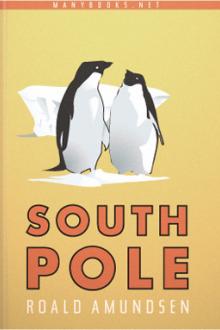The North Pole by Robert E. Peary (room on the broom read aloud .TXT) 📕

- Author: Robert E. Peary
- Performer: -
Book online «The North Pole by Robert E. Peary (room on the broom read aloud .TXT) 📕». Author Robert E. Peary
During the moonlit period of each month, some eight or ten days, when the moon seems to circle round and round the heavens, the younger members of the expedition were nearly always away on hunting trips; but during the longer periods of utter blackness most of us were on the ship together, as the winter hunting is done only by moonlight.
It must be understood that the arctic moon has its regular phases, its only peculiarity being the course it appears to travel in the sky. When the weather is clear there is starlight, even in the dark period; but it is a peculiar, cold, and spectral starlight, which, to borrow the words of Milton, seems but to make the "darkness visible."
When the stars are hidden, which may be much of the time, the darkness is so thick that it seems as if it could almost be grasped with the hand, and in a driving wind and snowstorm, if a man ventures to put his head outside the cabin door, he seems to be hurled back by invisible hands of demoniacal strength.
During the early part of the winter the Eskimos lived in the forward deck house of the ship. There was always a fire in the galley stove, a fire in the Eskimo quarters, and one in the crew's quarters; but though I had a small cylindrical coal stove in my cabin, it was not lighted throughout the winter. Leaving the forward door of my cabin open into the galley a part of the time, kept my cabin comfortably warm. Bartlett occasionally had a fire in his cabin, and the other members of the expedition sometimes lighted their oil-stoves.
On the first of November we adopted the winter schedule of two meals a day, breakfast at nine, dinner at four. This is the weekly bill of fare which Percy, the steward, and I made out and which was followed throughout the winter:
Monday. Breakfast: Cereal. Beans and brown bread. Butter. Coffee. Dinner: Liver and bacon. Macaroni and cheese. Bread and butter. Tea.
Tuesday. Breakfast: Oatmeal. Ham and eggs. Bread and butter. Coffee. Dinner: Corned beef and creamed peas. Duff. Tea.
Wednesday. Breakfast: Choice of two kinds of cereal. Fish, forward (that is, for the sailors); sausage, aft (for the members of the expedition). Bread and butter. Coffee. Dinner: Steak and tomatoes. Bread and butter. Tea.
Thursday. Breakfast: Cereal. Ham and eggs. Bread and butter. Coffee. Dinner: Corned beef and peas. Duff. Tea.
Friday. Breakfast: Choice of cereal. Fish. Hamburger on starboard (our own) table. Bread and butter. Coffee. Dinner: Pea soup. Fish. Cranberry pie. Bread and butter. Tea.
Saturday. Breakfast: Cereal. Meat stew. Bread and butter. Coffee. Dinner: Steak and tomatoes. Bread and butter. Tea.
Sunday. Breakfast: Cereal. "Brooze" (Newfoundland hard biscuit, softened and boiled with salt codfish). Bread and butter. Coffee. Dinner: Salmon trout. Fruit. Chocolate.
Our table conversation was mainly with regard to our work. We would discuss the details of the last sledge trip, or talk over the plans for the next one. There was always something going on, and the minds of the men were so occupied that they did not have time to yield themselves to the traditional, maddening winter melancholy of the Arctic. Moreover, men of sanguine temperament had been selected, and much material in the rough had been carried along in order to keep everybody busy working it into shape for use.
On Sunday mornings I breakfasted in my cabin, thus leaving the men to themselves. On these occasions conversation was less technical and ranged from books to table manners, and sometimes Bartlett seized the opportunity to give his companions half-serious, half-humorous advice on the matter of table conduct, telling them that the time would come when they must return to civilization, and that they must not allow themselves to get into careless habits. Thus the academic and the practical elements of the party met on even ground.
I have never adopted rigorous rules for the members of my expeditions, because it is not necessary. There were regular hours for meals in the mess rooms. It was understood that lights should be out at midnight, but if any man wanted a light later, he could have it. These were our rules.
The Eskimos were allowed to eat when they pleased. They might sit up late at night, if they chose, but their work of making sledges and fur clothing had to proceed just the same the next day. There was only one rigid rule for them: that no loud noises, such as chopping dog meat or shouting, were to be made from ten o'clock at night until eight in the morning.
While living on the Roosevelt, in winter quarters, we abandoned much of the routine of ship life afloat. The only regular bells were those at ten and twelve at night, the first a signal for all loud noises to cease, the latter a signal for lights to be turned out. The only watches were those of the regular day and night watchmen.
With the exception of a few cases of grip, the health of the party was good during the whole period of our life at winter quarters. Grip in the Arctic, coincident with epidemics in Europe and America, is rather an interesting phenomenon. My first experience with it was in 1892, following one of the peculiar Greenland storms, similar to those in the Alps—a storm which evidently swept over the entire width of Greenland from the southeast, raising the temperature from the minus thirties to plus forty-one in twenty-four hours. Following that atmospheric disturbance every member of my party, and even some of the Eskimos, had a pronounced attack of grip. It was our opinion that the germs were brought to us by this storm, which was more than a local disturbance.
Aside from rheumatism and bronchial troubles, the Eskimos are fairly healthy; but the adults are subject to a peculiar nervous affection which they call piblokto—a form of hysteria. I have never known a child to have piblokto; but some one among the adult Eskimos would have an attack every day or two, and one day there were five cases. The immediate cause of this affection is hard to trace, though sometimes it seems to be the result of a brooding over absent or dead relatives, or a fear of the future. The manifestations of this disorder are somewhat startling.
The patient, usually a woman, begins to scream and tear off and destroy her clothing. If on the ship, she will walk up and down the deck, screaming and gesticulating, and generally in a state of nudity, though the thermometer may be in the minus forties. As the intensity of the attack increases, she will sometimes leap over the rail upon the ice, running perhaps half a mile. The attack may last a few minutes, an hour, or even more, and some sufferers become so wild that they would continue running about on the ice perfectly naked until they froze to death, if they were not forcibly brought back.
When an Eskimo is attacked with piblokto indoors, nobody pays much attention, unless the sufferer should reach for a knife or attempt to injure some one. The attack usually ends in a fit of weeping, and when the patient quiets down, the eyes are bloodshot, the pulse high, and the whole body trembles for an hour or so afterward.
The well-known madness among the Eskimo dogs is also called piblokto. Though it does not seem to be infectious, its manifestations are similar to those of hydrophobia. Dogs suffering from piblokto are usually shot, but they are often eaten by the Eskimos.
The first winter moon came early in November, and on the 7th MacMillan started for Cape Columbia for a month of tidal observations, taking with him Jack Barnes, a sailor, Egingwah, and Inighito and their wives. Poodloonah, Ooblooyah and Seegloo went as MacMillan's supporting party, to carry supplies, and Wesharkoopsi and Keshungwah started for Cape Richardson to bring back the musk-ox skins which had been left there during the fall hunting trips.
The tidal observations by MacMillan at Cape Columbia were made in connection with the tidal observations which were constantly going on at Cape Sheridan during the fall and winter, and with those taken later at Cape Bryant on the other side of Robeson Channel. These tidal observations of the expedition of 1908-09 were the farthest north of all continuous series ever recorded anywhere, though similar observations had been taken by the Lady Franklin Bay Expedition at Fort Conger, about sixty miles southwest.
Marvin and Borup, during the November moon, continued the tidal observations at Cape Sheridan. The tidal igloo, which was built on the ice just inside the tide crack, about one hundred and eighty yards from the ship, was an ordinary Eskimo snow igloo and was used as a protection to the men in taking the observations at the tide staff. This staff, about twelve feet long, was driven into the bottom, and its length was marked off in feet and inches. As the tide rose and fell, the ice and the igloo moved with the water, but the staff remained stationary, and by the position of the ice upon the staff we measured the tides, varying with the day, the moon and the season.
The tides along the north coast of Grant Land are remarkable for the slightness of the rise and fall, which varies from an average of 1.8 feet at Cape Sheridan to .8 at Cape Columbia. As is well known to navigators, the tides at Sandy Hook, New York, sometimes rise twelve feet, while the tides in the Bay of Fundy are often over fifty feet; in Hudson Strait they are about forty, and there are places on the coast of China where the extreme rise is even greater.
The two Eskimo women were sent to Cape Columbia with MacMillan's party because the Eskimo men like to have their families with them when they go on long trips. The women are useful in drying and mending the fur garments which are constantly going to pieces in the rough usage of the sledge trips. Some of them can drive a dog team as well as the men, and many of them are good shots. I have known them to shoot musk-oxen and even bears. They do not attempt the walrus, yet they can paddle a kayak as well as the men—to the limit of their strength.
The accomplishments of the Eskimo women are of the useful rather than the ornamental kind. The handling of the native lamp, for instance, requires great skill. If the lamp is well trimmed, it is as clear and smokeless as our own lamps; if it is neglected, it smokes and smells vilely. As the Eskimos are not highly romantic, a woman's skill in dressing skins and in making clothes largely determines the quality of husband she is likely to get. The Eskimo men have not a very critical eye for feminine beauty, but they are strong in appreciation of domestic accomplishments.
Even so early as November we began to be worried about the dogs. Many of them had died; they were nearly all in poor condition, and the food was none too abundant. It is always necessary to take up twice as many dogs as will be needed, in order to provide for probable accidents. On the 8th of November there were only one hundred





Comments (0)